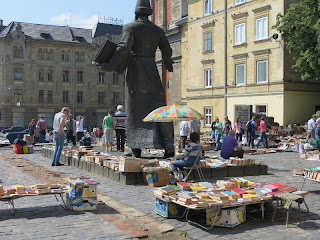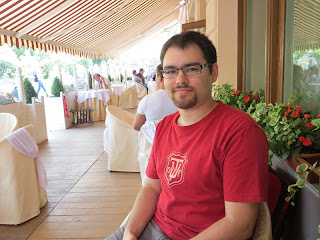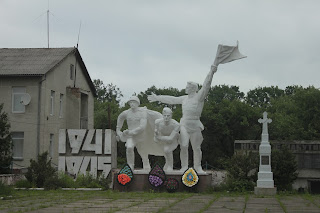This is a post by Lev with a bit of help by Marla:
------------------
After bad rain, thunderstorms, and rocky and muddy paths masquerading as highways, we're finally here in L'viv. But we don't want to get ahead of ourselves, as the story of how we got here and what we saw along the way is certainly an interesting one.
Our driver, Bohdan, picked us up from our hotel in Odesa on Wednesday morning. For the next eleven hours we were on the road to Kamianets-Podilskyi (hereinafter referred to as KP otherwise this blog will be charged for breach of laws about length!). After a couple of wrong turns, and seriously potholed roads, which required that he drive at about 20 km an hour for much of the trip, we finally ended up at our very nice hotel in the old part of KP. After a late dinner (10 pm), we fell asleep quickly and awoke early to a beautiful Thursday morning.
We got up and out of the hotel extra early to catch the sights and beat the heat. The first thing we saw was the city hall and bell tower from our hotel window.
Upon leaving the hotel we happened upon a modern sculpture, which reflected the day ahead of us.
 |
| This is not a statue but instead a real tourist dipped in bronze from 1989 |
Immediately afterwards we visited a church (now a convent) that had a minaret erected when the Ottomans had taken the city in 1672. KP was given back to the Poles with the promise that they would not tear down the minaret. The Poles agreed and left the minaret standing. But the agreement didn't stop them from erecting a golden statue of the Virgin Mary on top of the minaret. It still stands today.
 |
| Even in the 17th century, everyone hated lawyers and their legal loopholes |
After that, we saw the former Dominican monastery, the Armenian tower, and the ancient castle that stands on a hill across from the old town. The name of KP comes from the rock it sits upon (the name literally means the rock of Podil). The only way to enter the castle is by bridge, and, once inside, there are various museums and activities (for a price).
 |
| Sorry Starship, they built this city more on rock than roll |
The whole place looked like it was right out of Poland, and some of the signs were indeed, written in Polish for the many Polish tourists.We were happy that we had left the hotel early because by noon the whole town was teeming with tour groups and tour buses. We checked out of our hotel, and got on the road for Khotyn and had a quick lunch on the road. We arrived at Khotyn later in the afternoon.
 |
| This natural spring indicates, helpfully, that it is located in Ukraine. |
Khotyn was the site of the tremendous victory by Poles and Ukrainian Cossacks over the Ottoman Empire. It was said that 40,000 Cossacks, led by Hetman
Petro Konashevych-Sahaidachny, as well as Polish regular forces, defeated 200,000 Ottoman troops. There was also another victory over the Turks in 1673, but since no Ukrainians were involved, it doesn't get mentioned much in Ukrainian popular history. The fort finally fell to the Ottomans in 1713, but since they took it from Moldavans, and not Ukrainians, one could say... no harm, no foul. ;)
 |
| This ancient-looking sign could be from the time of that first Turkish invasion... or maybe just 2002 |
While the fort has fallen into disrepair since the 18th century, most of the current structure is rebuilt from historical blueprints. Only a cobblestone road leads from the outer gate to the keep.
 |
| It's just as steep and ankle-breaking as it appears |
It is quite impressive in itself, but more impressive is the landscape surrounding it. Between its outer and inner walls, large rolling green hills descend to the castle walls in the valley below.
 |
| Eat your heart out, Ireland |
Since the fort sits right on the shore of the nearby Dnieper river, the foundations are quite damp and cool.
 |
| If Ukraine had better wines, this could make a good wine cellar |
In any case, we departed after only about an hour at Khotyn so that we could make it in time to get to Chernivtsi in daylight. And it was a good thing we did. The roads were horrible.
 |
| *dramatic music* dun, Dun, DUN! |
After about a 2 hour, we arrived in Chernivtsi. Known as Czernowitz to Ukrainian Jews, this once-shining city had been the capital of the Bukovina province of Austria-Hungary. Now, it is a relatively isolated university town just a stone's throw from the Romanian border.
 |
| The sign on the archway reads 'University' (or 'Party-Central' if you are a student) |
Needless to say, Chernivtsi is best known for its university.
 |
| ... and not particularly for the quality of its education |
The campus is a UNESCO heritage site and is a sight to behold. The colourful shingles, bizarre shapes and earthy red colour make it seem like something out a children's story.
 |
| This was originally the house for the Metropolitan of the Greek Catholic Church but he got dizzy from the roof patterns and had to move out |
Hidden behind the university, there is a wonderful park with large old growth trees, comfortable benches, and a plethora of songbirds.
 |
| Think less London's Hyde Park, more Bavaria's Schwarzwald |
Unfortunately, storm clouds were on the horizon and thunder was echoing among the buildings. In the face of a soon-to-be downpour, we rushed off to the Chernivtsi Palace of Culture, the former Jewish National House. Located in Theatre Square, this impressive structure was constructed in 1908.
 |
| Palace of Culture indeed |
Unfortunately, the many Jews that called 'Czernowitz' home no longer live there. The building now houses the museum of history of Bukovinan Jews and acts as a community centre for what appears to be a still rather active, if small, community.
 |
| This noble lion now guards the calendar of events, which is good because Timmy keeps trying to deface it |
After this quick stop, we rushed off to the building that interested me the most, the Ukrainian National House. But not for the reasons you would think. The building served as the home of the First Yiddish Language Conference in1908.
 |
| The only image I could find of the Ukrainian National House came from this postcard |
The address of the building is not advertised anywhere, and it no longer serves the same purpose as it once did. However, after some research and a couple of hours using Google Street view, I discovered its location. It was exciting to find the building, and despite an increasingly active rain storm, I ran out to take photographs of the building that was central to my Master's Thesis.
 |
| I turned down taking an umbrella outside because I'm smart like that. |
While it definitely was the right building, it's not 100% clear in which room the meetings were held. My best bet is that the room is still the conference room, but I will have to return to do more research before I can confirm this.
 |
| 1908 |
 |
| 2013 |
After that excitement, we rushed back to the hotel before the storm could get any worse. We ate a strange dinner-related meal and had a fitful night in a renovated Radyanske-era hotel.
 |
| It included such highlights like fua gwa (foie gras), chicken souffle, and, as pictured here, "a nut is a cedar." |
|
Strangely, the top floor of the hotel (6th floor) was off-limits and attempting to hit the 6th floor button in the cramped and musty elevator sent one instead to the basement.
 |
| The plants add a certain level of creepiness to the whole situation, no? |
We left Chernivtsi in the morning with the threat of more rain and a long drive to L'viv ahead of us. More on that tomorrow. We'll also try to report on our visit to L'viv before I leave for school tomorrow (taking the computer with me), but if not, you can expect a final update after Marla and Yuri return to Toronto.




















































